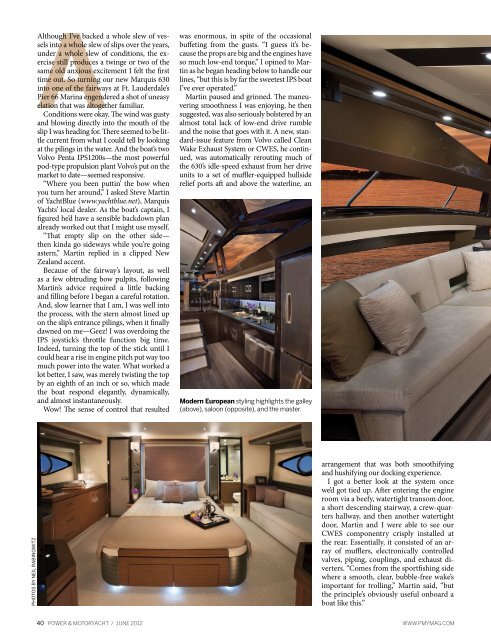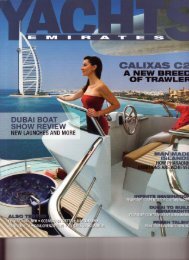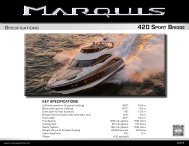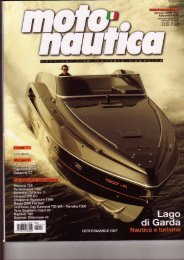PMY_Marquis 630 - Marquis Yachts
PMY_Marquis 630 - Marquis Yachts
PMY_Marquis 630 - Marquis Yachts
- No tags were found...
You also want an ePaper? Increase the reach of your titles
YUMPU automatically turns print PDFs into web optimized ePapers that Google loves.
Although I’ve backed a whole slew of vessels<br />
into a whole slew of slips over the years,<br />
under a whole slew of conditions, the exercise<br />
still produces a twinge or two of the<br />
same old anxious excitement I felt the first<br />
time out. So turning our new <strong>Marquis</strong> <strong>630</strong><br />
into one of the fairways at Ft. Lauderdale’s<br />
Pier 66 Marina engendered a shot of uneasy<br />
elation that was altogether familiar.<br />
Conditions were okay. The wind was gusty<br />
and blowing directly into the mouth of the<br />
slip I was heading for. There seemed to be little<br />
current from what I could tell by looking<br />
at the pilings in the water. And the boat’s two<br />
Volvo Penta IPS1200s—the most powerful<br />
pod-type propulsion plant Volvo’s put on the<br />
market to date—seemed responsive.<br />
“Where you been puttin’ the bow when<br />
you turn her around,” I asked Steve Martin<br />
of YachtBlue (www.yachtblue.net), <strong>Marquis</strong><br />
<strong>Yachts</strong>’ local dealer. As the boat’s captain, I<br />
figured he’d have a sensible backdown plan<br />
already worked out that I might use myself.<br />
“That empty slip on the other side—<br />
then kinda go sideways while you’re going<br />
astern,” Martin replied in a clipped New<br />
Zealand accent.<br />
Because of the fairway’s layout, as well<br />
as a few obtruding bow pulpits, following<br />
Martin’s advice required a little backing<br />
and filling before I began a careful rotation.<br />
And, slow learner that I am, I was well into<br />
the process, with the stern almost lined up<br />
on the slip’s entrance pilings, when it finally<br />
dawned on me—Geez! I was overdoing the<br />
IPS joystick’s throttle function big time.<br />
Indeed, turning the top of the stick until I<br />
could hear a rise in engine pitch put way too<br />
much power into the water. What worked a<br />
lot better, I saw, was merely twisting the top<br />
by an eighth of an inch or so, which made<br />
the boat respond elegantly, dynamically,<br />
and almost instantaneously.<br />
Wow! The sense of control that resulted<br />
was enormous, in spite of the occasional<br />
buffeting from the gusts. “I guess it’s because<br />
the props are big and the engines have<br />
so much low-end torque,” I opined to Martin<br />
as he began heading below to handle our<br />
lines, “but this is by far the sweetest IPS boat<br />
I’ve ever operated.”<br />
Martin paused and grinned. The maneuvering<br />
smoothness I was enjoying, he then<br />
suggested, was also seriously bolstered by an<br />
almost total lack of low-end drive rumble<br />
and the noise that goes with it. A new, standard-issue<br />
feature from Volvo called Clean<br />
Wake Exhaust System or CWES, he continued,<br />
was automatically rerouting much of<br />
the <strong>630</strong>’s idle-speed exhaust from her drive<br />
units to a set of muffler-equipped hullside<br />
relief ports aft and above the waterline, an<br />
Modern European styling highlights the galley<br />
(above), saloon (opposite), and the master.<br />
Photos By Neil Rabinowitz<br />
arrangement that was both smoothifying<br />
and hushifying our docking experience.<br />
I got a better look at the system once<br />
we’d got tied up. After entering the engine<br />
room via a beefy, watertight transom door,<br />
a short descending stairway, a crew-quarters<br />
hallway, and then another watertight<br />
door, Martin and I were able to see our<br />
CWES componentry crisply installed at<br />
the rear. Essentially, it consisted of an array<br />
of mufflers, electronically controlled<br />
valves, piping, couplings, and exhaust diverters.<br />
“Comes from the sportfishing side<br />
where a smooth, clear, bubble-free wake’s<br />
important for trolling,” Martin said, “but<br />
the principle’s obviously useful onboard a<br />
boat like this.”<br />
LOA: 65'8"<br />
BEAM: 17'2"<br />
DRAFT: 4'6"<br />
DISPL.: 71,500 lb.<br />
FUEL: 1,030 gal.<br />
WATER: 160 gal.<br />
TEST POWER: 2/900-hp Volvo Penta IPS1200s<br />
TRANSMISSION: Volvo Penta IPS1200<br />
w/ 1.88:1 ratio<br />
PROPULSION: IPS Pod drives w/Volvo Penta<br />
Q3 propset<br />
OPTIONAL POWER: None<br />
GENERATOR: 1/23 kW Kohler<br />
BASE PRICE: $2,650,000<br />
PRICE AS TESTED: $2,870,000<br />
Noteworthy Options:<br />
Crew quarters $9,685; bridge hardtop with<br />
retractable canvas sunroof $32,200; bridge<br />
wet bar with Raritan ice maker $2,385; Norcold<br />
refrigerator $2,070 and Kenyon s/s grill $2,310<br />
40 POWER & MOTORYACHT / JUNE 2012 WWW.<strong>PMY</strong>MAG.COM WWW.<strong>PMY</strong>MAG.COM<br />
JUNE 2012 / POWER & MOTORYACHT 41







